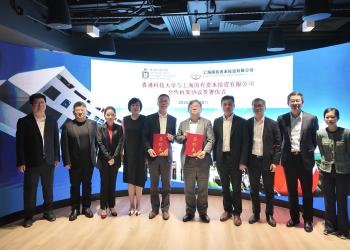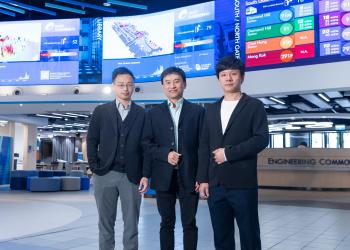HKUST Researchers Discover New Virus Traits That May Help Fight Global Warming and Develop Anti-virus Drug
Oxygen levels in the ocean have depleted over the past few decades1 due to global warming and emissions of greenhouse gas, causing pollution and disrupting our ecosystem. In efforts to curb the trend, researchers from the Hong Kong University of Science and Technology (HKUST) discovered a mechanism that may eventually help an eco-friendly aquatic bacterium clean up more carbon dioxide in the ocean and produce more marine oxygen.
Like trees on land, cyanobacteria, or what commonly known as blue-green algae, perform photosynthesis in the ocean. They provide oxygen for marine life and absorb over 20% of the world’s total carbon emission. However, natural predation and virus infection kill nearly half of the world’s cyanobacteria on a daily basis. A virus called cyanophage alone, wipes out one fifth of the total cyanobacterial population every day.
A research team led by Prof. ZENG Qinglu, Associate Professor of the Department of Ocean Science at HKUST, has recently discovered how the virus cyanophage comes to kill that eco-friendly bacteria. After five years of study, it was found for the first time that the weapon that cyanophage used against its host was in fact the energy emitted from the host’s photosynthetic activity. Laboratory experiment using cultured cyanophages has revealed that cyanophage cannot fully function in darkness, yet, the algae was still killed at night. It was because the virus has completed the infection process during the daytime - fueled by the energy they obtained from the blue green algae’s photosynthesis activities, eventually causing the disintegration of its cell structure at night. Many living organisms, including humans who are active during the day and rest at night, follow diurnal rthyms, but this is the first time diurnal rhtyhms are also observed in viruses.
“By knowing how the light-dark cycle controls the infection process of cyanophage, not only can it help minimize the risk of infection for cynobacteria, thereby boosting its ability to absorb CO2 to help slow down global warming, but may also shed light on future research into medication against viruses,” Prof. Zeng said. “Many human diseases are caused by human viruses. Now that we know viral infection can be affected by the circadian rhythm and the light-dark cycle, it may offer insights into drug development against human viruses.”
The findings were recently published in scientific journal Proceedings of the National Academy of Sciences of the United States of America (PNAS).
1According to a scientific research published in Nature in 2017, the ocean had lost more than 2% of oxygen over the past 50 years, and the pace is expected to quicken to up to 7% over the next 80 years, causing potentially detrimental damages to fisheries and coastal economies.
About The Hong Kong University of Science and Technology
The Hong Kong University of Science and Technology (HKUST) (www.ust.hk) is a world-class research university that focuses on science, technology and business as well as humanities and social science. HKUST offers an international campus, and a holistic and interdisciplinary pedagogy to nurture well-rounded graduates with global vision, a strong entrepreneurial spirit and innovative thinking. HKUST attained the highest proportion of internationally excellent research work in the Research Assessment Exercise 2014 of Hong Kong’s University Grants Committee, and is ranked as the world’s best young university in Times Higher Education’s Young University Rankings 2019. Its graduates were ranked 16th worldwide and top in Greater China in Global Employability University Survey 2018.
For media enquiries, please contact:
Anita Lam
Tel: 2358 6313
Email: anitalam@ust.hk
Jamie Wong
Tel: 3469 2512
Email: jamiewong@ust.hk










